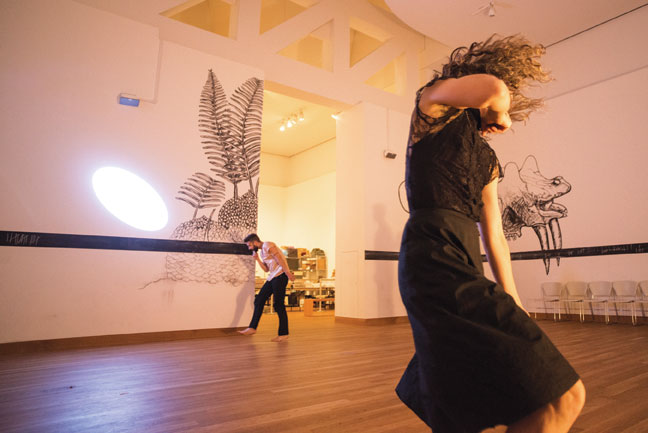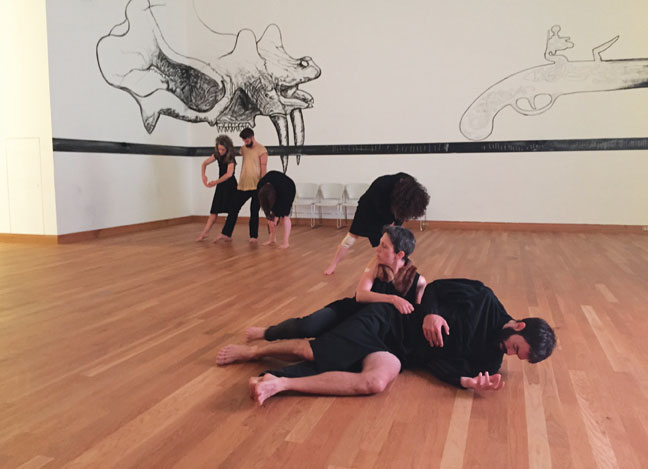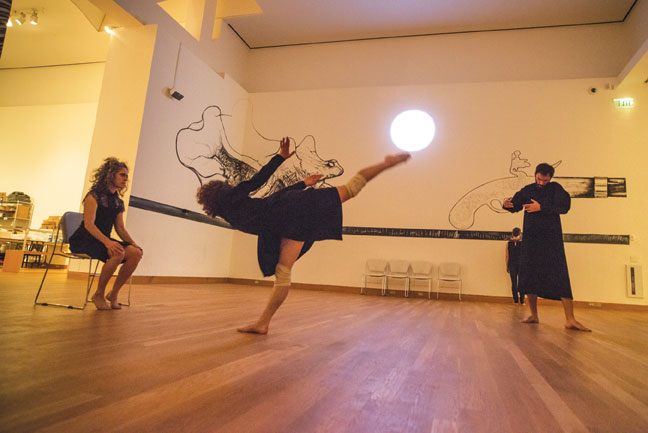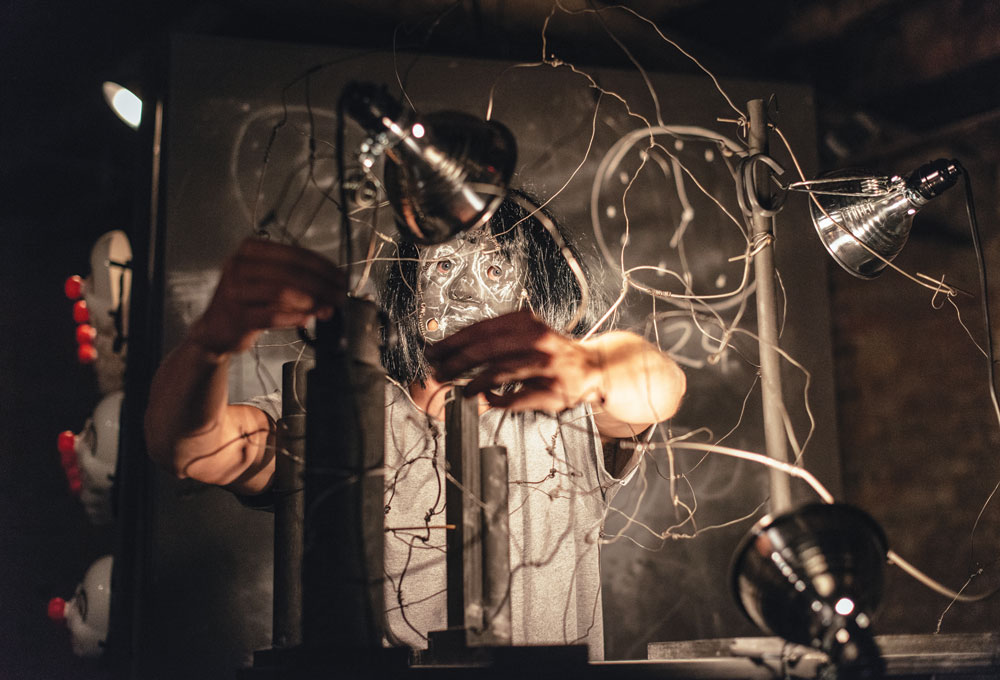« Features
The Art of Trespass: Still Life and Tuning Device
Rather recently, the choreographic has captured the imagination of curators.1 The choreographic has left the world of dance and performance on stage and entered galleries, where, for the duration of an exhibition, bodies perform scores and gestures amid more traditional art objects and audiences. The effects of this curatorial practice involve both alienation and activation: a putatively neutral gallery space grows strange by containing both the cultural choreography of art appreciation alongside other forms of deliberate and no less disciplined movement. The gallery as an institutional frame and background fades and something else emerges: a charged space of encounter and inter-activation, uncertain and potentially precarious. This exhibition practice is no longer limited to the opening night spectacle but endures. From long-form choreography to random activations of sculptural objects, the choreographic occupies a curious position in the current politics of audience engagement.

Morgan Thorson, Still Life, dance installation as part of the exhibition “Local Time,” curated by Diane Mullin. Weisman Art Museum, University of Minnesota, Minneapolis (June 13 – September 13, 2015). Concept and choreography: Morgan Thorson. Scenic design: Morgan Thorson and Joel Sass. Lighting: Morgan Thorson and Lenore Doxsee. Costumes: Sarah Baumert. This Photo: Performers: Kristin Van Loon and Max Wirsing. Photo: Valerie Oliveiro.
“Trespassing into discourses and disciplines of visual-sculptural-audial-philosophic practice, the choreographic works against linguistic signification and virtuosic representation; it is about contact that touches even across distances.”2 In Jenn Joy’s characterization, the choreographic acts as an unruly interloper whose gestures carve out a vibrant zone of convergence between sculpture and performance, movement and stillness, where bodies experience space and temporality. In what follows, I turn to two artists, Morgan Thorson and John Fleischer to consider how their work opens up uncharted, nameless terrain in contemporary art that invites and even encourages all forms of trespassing. By turning to two recent works, Thorson’s Still Life and Fleischer’s Tuning Device (both 2015), I ask how these artists invite us to pass into this convergence zone. What might be learned from entering this zone? What risk does it hold, what promise?
Thorson’s trespass begins in dance but has grown to incorporate Lenore Doxsee’s light design, wall drawings by Joel Sass, and a sound track by Dana Wachs. Still Life, a work the artist describes as long-form choreography, took place at the Weisman Art Museum in Minneapolis from June to September 2015. Part of a group show titled “Local Time” and curated by Diane Mullin, Still Life brought a different group of performers to the museum each week. For five hours a day, five days a week, bodies would spin, slide, crawl, push and pull, collide and, only occasionally, settle into the slow sway of a shared rhythm.
The score for Still Life resembles an instruction manual: pass through three forms in ten minutes. Now, move every thirty seconds. Do ten forms in five seconds. Shaped by time, movements loop. Each form is distilled to its essence over five hours. Muscle memory takes over as gestures recur: a shudder, a jolt, a shimmy of shoulders; a slow rotation on pointed toes, a promenade in twos, chins held in mock mimicry of ponderousness. Never finite, gestures are slowed to the point where they become something else. Movement flickers. Swarms of bodies gather and dissemble. Efficiency meets exuberance, elation exhaustion.
Chairs line the walls. Some of them become props before they return to their positions on the periphery. I sit, unsure about how my position will implicate me. My body turns into another object the dancers to move around. They come very close: there is no separation between stage and audience. I smell bodies that have been moving for hours. Occasionally, one of the dancers meets my eyes. As they stand next to me, I listen to their breathing. I follow the minute movements of fingers, uncurling ever so slowly, up close. Sequences of urgent movement segue into moments of stillness. A body breaks from the group and runs a loop through the museum. A visitor participates for a few moments, cavorting with arms raised high. Laughter erupts from dancers and visitors. Still Life opens a space of strange intimacy.
The dancers’ bodies act like animated marks in the white gallery box, contracting and extending, marking space and keeping time in a three-dimensional drawing composed of ever-shifting variables. Space acts as material to be shaped and molded by moving bodies. Dressed in black and white, they glint with occasional flourishes of color: a sheer veil, a hint of gold lamé, a whisper of fur.

Performers: Kristin Van Loon, Arwen Wilder, Sam Johnson, Max Wirsing and Emily Gastineau. Photo: Morgan Thorson.
Still Life is concerned with marking time, with bodies keeping time. The title suggests continuity despite hindrances, something lasting, resilient, capable of perseverance. But just as easily, the title can tilt toward stillness, death, extinction. The wall drawings suggest as much: ancient ferns, a saber-toothed skull, the skeleton of a dinosaur and a pistol, no longer manufactured. Time has run out. Between the drawings, just below eye level, a bar painted in chalkboard black runs across the walls. The dancers have been keeping count: white lines in bundles of four, a fifth line crossing them are reminiscent of prison walls of old where, in the absence of other timepieces, inmates would etch and smear such lines to count the days. But Still Life also irreverently riffs on the genre of painting the still life. Traditionally concerned with portraying a particular order in the world, the still life served to stabilize and regulate the proper place of objects in the world.3 The genre’s unspoken rules affirmed that there was order in the world, that the important could be clearly distinguished from the insignificant. Still Life continues this negotiation of a political economy of attention. As a result, order gives way to precarity. Still Life is equally open to serendipity-when the loops of movement, sound, and light align just so-and, more interesting still, failure.
Failure opens up a space of disorientation, where things no longer make sense. John Fleischer’s Tuning Device, like Thorson’s Still Life, deliberately risks illegibility and sets up opportunities for such spaces to emerge. Elusive, such situations cannot be fully determined: what emerges is the result of an interplay, a feedback loop, between being affected by and in turn affecting the unfolding of the work. “To engage choreographically,” writes Joy, “is to position oneself in relation to another, to participate in a scene of address that anticipates and requires a particular mode of attention, at times against our will.”4 Enter at your own risk.
Fleischer’s practice grows out of sculpture. His work often moves from considering the object to the kinds of actions and activities that the object suggests. If objects come complete with an in-order-to structure, a material intentionality, Fleischer’s carefully crafted artifacts point toward forms of interaction conjured by the object. In Tuning Device, a work included in the 2015 Minnesota biennial, titled “superusted” and curated by Cheryl Wilgren Clyne for the Soap Factory in Minneapolis, a gated ramp led to a stage of eight by eight feet, where a tangle of wire sat on top of a table. Back stage, a wall held an array of identical masks. Fleischer refers to this area as the dressing room, where “activators” transition into their roles. Painted in black chalkboard paint, the whole set allowed for words, images, and diagrams to be added and erased. At unspecified times during the run of the exhibition, two performers activated Tuning Device. One of the masked characters occupied a station on stage, tracing a ring around the coils of wire slowly and with fierce concentration; the other was positioned at the ramp as a “guard” who wordlessly interacted with visitors interested in ascending the ramp.
Tuning Device is rooted in a story Fleischer recounts and perhaps misremembers. Lodged somewhere in the space between memory and imagination, the story involves a figure who appears at a threshold, moves in unfamiliar ways, and departs. The equally fictional observer who witnesses the specter’s strange gestures has not yet grown the organs to interpret the visitor’s wordless gift. In Tuning Device, Fleischer’s activators ask us to feel our way through signs and gestures, actions and allusions that do not give in to making sense readily. Masked, their gestures remain cryptic but nonetheless appear purposeful. The work asks us to linger in confusion, to resist, for a little while, the impulse (or compulsion) to figure it all out. It is not futility that Fleischer’s work flirts with; instead, a sense of “not yet” permeates the work, as if we are slowly drifting closer to something still un-nameable if only we let the current sweep us along.
The title, Tuning Device, alludes to anticipation, a prelude to the thing itself: a tuning fork in music sets the correct pitch for a performance yet to come. A tuning device prepares an automobile for perfect performance. In Tuning Device, what is yet to come is unknown and quite possibly unknowable. But the work asks us to attune to the way sculptural objects, writing, and movement interact to create an unexpectedly intimate experience between suspense and suspension: the absurd tension Tuning Device is at times capable of creating refuses to resolve. No catharsis, no denouement, no comfort in certainty-only a strange fascination with a possible passage into a nameless, uncharted space, sensed rather than known by reason.
If Still Life transforms the gallery space into a three-dimensional drawing that, as soon as you enter, you participate, whether deliberately or inadvertently, Tuning Device sets up a threshold that divides space and offers a physical encounter with liminality. Space is no longer neutral or spread evenly but bundles, coils, and thickens in some places more than others. Temporality, too, is negotiated in the choreographic as it manifests in Thorson’s and Fleischer’s work: Still Life’s sheer duration allows for a gradually growing knowledge by acquaintance, a slow process of becoming familiar. Expectations based on past experience prove reliable, sequences of movement recognizable, even if the bodies and their numbers differ. Tuning Device offers no such metaphors of organic communication honed by the passage of time. And yet the challenge the work presents is not farfetched: how do we attune to the strange, the foreign, that which eludes our horizon of reference but still registers as stubbornly purposeful? Fleischer does not propose an answer; indeed, Tuning Device required him to renege artistic control and surrender to the work’s unpredictability, its refusal to make itself known. What emerges in the process, though, is an oblique spatial, embodied, and performed narrative that opens a space where something communicates itself.
The art of trespass, then, is not to be misunderstood as artfully mixing disciplines: a dash of dance with a hint of sculpture, flavored by sound, light, and performance. It is not crossing into foreign territory as much as passing across and thus transforming the space we are already in into something stranger than fiction. In Thorson’s Still Life, this space opens beyond exhaustion and exuberance,5 after hours of movement, interspersed with frenetic counting and occasional hilarity. Far from convalescence, as Jan Verwoert theorizes the aftermath of exhaustion and exuberance, this space is more reminiscent of ecstatic practices of old, when bodies served as vehicles to achieve transcendence. Here, though, nothing is transcended. We are still here; no specter of divinity to behold. Yet, as Tuning Device suggests, once we attune to the place we are in, this ‘here’ becomes momentarily or irrevocably altered.
Notes
1. At the 2016 College Art Association’s conference in Washington, D.C., a panel explored “Thinking the Choreographic,” while Jenn Joy’s The Choreographic (Cambridge, MA: MIT Press, 2014) offers a rigorous and far-ranging theorization of a contemporary understanding of the practice.
2. Jenn Joy, The Choreographic. Cambridge, MA: MIT Press, 2014, p. 1.
3. In “Abundance,” Norman Bryson argues, “still life was able to provide its viewers with images in which the historically unprecedented instability and volatility of their material culture could appear as regulated and stabilized. In this work of visual ideology, the discourse of ethics is joined by a force no less stabilizing, that of craft labor. Amid the general uncertainty and anxiety surrounding consumption, still life affirms skilled labour as a kind of gold standard that will hold its own through all the vicissitudes of (over)abundance.” (Looking at the Overlooked. Four Essays on Still Life Painting. Cambridge, MA: Harvard UP, 1990, p. 132).
4. Jenn Joy, Ibid.
5. Jan Verwoert, “Exhaustion and Exuberance.” Center for Advanced Visual Studies at MIT. <http://www.artsheffield.org/2008/pdfs/exhaustion-exuberance.pdf>
Christina Schmid is a writer, critic, teacher and curator. She works at the University of Minnesota’s Department of Art, where she teaches contemporary practices and critical theories. Her essays and reviews have been published both online and in print, in anthologies, journals and digital platforms, including Artforum, Flash Art, Foam Magazine, afterimage and mnartists.com.








































Leave a Reply
You must be logged in to post a comment.